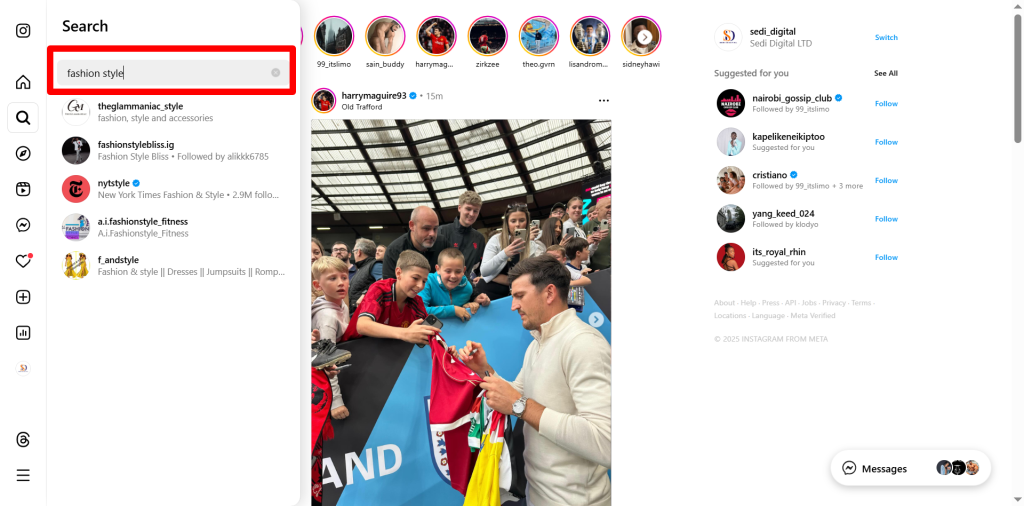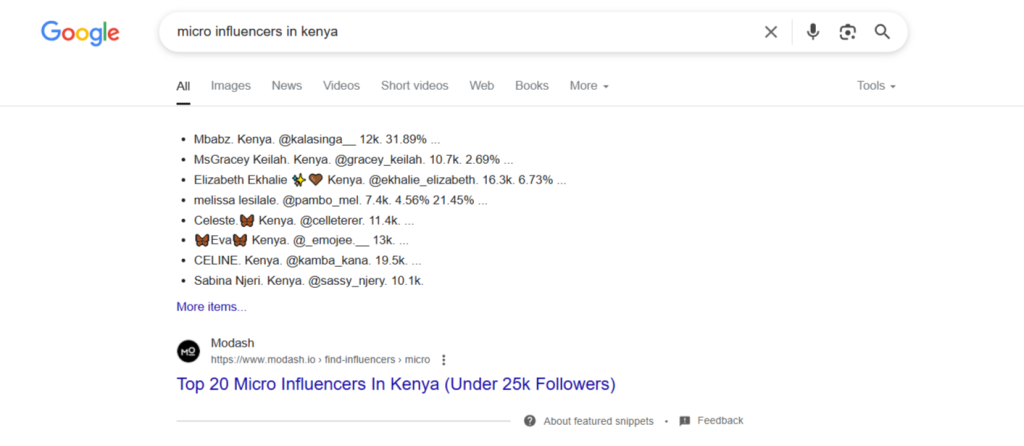I recently bought a stylish pair of Ankara sneakers from TikTok Shop just because a Kenyan micro-influencer posted about them.
That’s the power of influencer marketing today. Whether they have 1,000 or 100,000 followers, influencers can drive real purchase decisions.
In fact, 63% of consumers are more likely to buy a product recommended by someone they trust online.
Also Read: Influencer Marketing in Kenya: Guide for Brands & Businesses
In my role managing international influencer campaigns at Nickelodeon, I’ve seen firsthand how effective the right influencer strategy can be especially for brands with limited budgets.
But not every business can afford to hire celebrities or top-tier creators. That’s where micro-influencers shine.
In this guide, I’ll walk you through everything you need to know about micro influencer marketing in Kenya from why it works, to local brands doing it well, and how you can start partnering with micro-influencers to promote your business.
What is a Micro-Influencer?
In the context of micro influencer marketing Kenya, a micro-influencer is a social media content creator with anywhere between 10,000 to 100,000 followers, often focusing on a specific niche like fashion, fitness, tech, parenting, or even local business trends.
These creators aren’t mainstream celebrities or household names. They’re everyday Kenyans who have built loyal, highly engaged audiences around their passions whether it’s reviewing affordable beauty products, showcasing thrifted outfits from Gikosh, or sharing farming tips on TikTok.
Instead of flashy, sponsored ads, brands collaborate with micro-influencers for authentic, relatable content the kind that feels like a recommendation from a friend, not a sales pitch. And while their follower count may be smaller compared to major influencers, their audience trusts their opinions and is more likely to take action.
That’s the real power behind micro influencer marketing in Kenya quality engagement over quantity, and relevance over reach.
What is Influencer Marketing?
Influencer marketing is when a brand partners with a content creator someone with a strong social media following to promote products or services to that creator’s audience.
It works because people tend to trust recommendations from individuals they relate to or admire. Instead of traditional ads, influencer marketing leverages word-of-mouth and social proof. Whether it’s a food blogger in Nairobi or a fashion enthusiast in Eldoret, influencers have built trust with their audiences and that trust drives action.
In Kenya, this strategy is growing fast, especially as more brands realize they don’t need to spend millions on a celebrity endorsement. Many are now turning to micro influencer marketing Kenya to get more authentic, targeted reach.
While some influencers are paid to create sponsored content or promote events, others may agree to barter deals for example, free products in exchange for a post or story. This flexibility makes influencer marketing accessible even for small businesses and startups.
Types of Influencers in Kenya
Influencers are grouped based on their number of followers. Here’s how they break down:
1. Nano-Influencers (1,000–10,000 followers)
These are everyday Kenyans with small, tight-knit online communities. Think of someone sharing skincare tips, campus fashion looks, or hustle stories on Instagram or TikTok. Their audience may be small, but engagement is often very high.
2. Micro-Influencers (10,000–100,000 followers)
This is the sweet spot for many local brands. Micro-influencers have a decent reach and are highly trusted in their niches whether it’s tech, parenting, beauty, or streetwear. That’s why micro influencer marketing in Kenya is gaining traction: it’s cost-effective, targeted, and impactful.
3. Macro-Influencers (100,000–1 million followers)
These are creators with nationwide recognition popular vloggers, comedians, or lifestyle influencers. They get lots of brand deals, but their content might not feel as personal or relatable as that of smaller influencers.
4. Mega-Influencers (Over 1 million followers)
These are celebrities think musicians, actors, or national personalities. Their reach is massive, but they often charge premium rates, and their audiences may be less engaged because of frequent brand promotions.
Why Micro-Influencer Marketing Works in Kenya
Micro-influencers offer a perfect balance for brands that want meaningful engagement without breaking the bank. Their audiences are loyal, niche-specific, and actively interact with their content. Since they’re often seen as “real people,” their product endorsements feel more genuine.
If you’re a brand looking to build trust, increase awareness, or boost sales, then tapping into micro influencer marketing Kenya might just be your smartest move.
The Value of Micro-Influencers in Kenya
At first glance, focusing your marketing budget on a smaller content creator may seem counterintuitive. Why choose someone with fewer followers to promote your brand?
But when it comes to micro influencer marketing Kenya, smaller often means smarter.
Here’s why working with micro-influencers can deliver better results than partnering with mega-celebrities:
1. Micro-Influencers Have Higher Engagement Rates

In the world of influencer marketing, quality matters more than quantity. A micro-influencer may have 10,000 followers, but if 2,000 of them consistently like, comment, or share their posts that’s powerful.
In fact, micro-influencers generate up to 60% more engagement than their macro and mega counterparts.
For example, the average engagement rate for micro-influencers on TikTok ranges between 8.37% to 17.96%, while mega-influencers often sit around 4.96% or lower.
Why? Because micro-influencers feel more approachable and trustworthy. They reply to comments, share everyday stories, and connect more personally with their audience whether it’s in Kisumu, Nairobi, or Mombasa.
2. Their Audiences Are More Targeted
Micro-influencers in Kenya often focus on specific niches like natural hair care, local fashion, parenting, fitness, or travel. Their followers are not just random fans; they follow because they relate deeply to the content.
Let’s say you’re a Kenyan fashion brand. You could partner with one mega-influencer with 1 million followers and get around 12,100 engagements (assuming a 1.21% engagement rate).
But if you work with seven fashion micro-influencers who each have 50,000 followers and a 3.86% engagement rate, you could end up with 13,510 engagements from people who are genuinely interested in fashion.
With micro influencer marketing in Kenya, you don’t just get more engagement you get relevant engagement.
3. They’re More Affordable
Big-name influencers often come with equally big price tags. Cristiano Ronaldo reportedly earns over $3 million for a single sponsored post. That’s not a realistic option for most businesses especially small brands or startups in Kenya.
Micro-influencers, on the other hand, are cost-effective. Many charge anywhere from KES 10,000 to KES 100,000 per post, depending on their niche and engagement. Some may even accept barter deals, like free products or services in exchange for content.
At Nickelodeon, for instance, we’ve partnered with micro-influencers in exchange for custom PR packages and it worked beautifully. Kenyan brands can do the same: send your product, create a memorable experience, and let the influencer do the storytelling.
4. They Feel More Authentic
Micro-influencers are everyday people. They create their own content, use their own voice, and interact directly with their audience. That authenticity builds trust and trust drives conversions.
Unlike celebrities with social media managers and scripted captions, micro-influencers keep it real. And because platforms like Instagram and TikTok reward authenticity, their content is more likely to appear on followers’ feeds or the For You Page (FYP).
This makes micro influencer marketing Kenya not only more affordable but also more impactful in today’s algorithm-driven world.
Also Read: Social Media Management in Kenya: Dominate with Semrush ($99)
How to Find Micro-Influencers in Kenya
Now that we understand the power of micro-influencers, the next big question is: how do you find them?
Whether you’re a fashion brand in Nairobi, a coffee startup in Kisumu, or a digital product creator in Mombasa, discovering the right micro-influencers in Kenya can boost your visibility and sales without breaking the bank.
Here’s how to find the best micro-influencers for your brand:
1. Use Influencer Discovery Tools
If you want a structured and data-driven approach, influencer discovery tools are a game-changer.
Platforms like Collabstr, Heepsy, or Tagger by Sprout Social let you filter influencers by:
- Follower count (10K to 100K)
- Niche or category (e.g., fashion, fitness, tech)
- Location (like Kenya or Nairobi)
- Engagement rate
- Audience demographics
- Preferred platform (Instagram, TikTok, YouTube)
Many tools offer free trials or demo requests. This is helpful when you’re just getting started or want to compare multiple tools before investing.
Pro Tip: Ensure the tool gives you access to key influencer data like average fees, contact info, brand collaborations, and engagement history.
2. Use Social Media Search (Free and Effective)

You don’t need paid tools to find micro-influencers you can start with Instagram or TikTok.
Here’s how to do it manually:
Step 1: Search relevant keywords or hashtags on Instagram, such as:
#kenyanfashionblogger#nairobifitnesscoach#kenyabeautyinfluencer#momsketokitchen(if you’re in food or parenting)
Step 2: Click on the “Accounts” tab to see user profiles instead of posts.
Step 3: Scroll past the large influencers and look for creators with 10K–100K followers.
Step 4: Check their bio, content style, and engagement. Do they tag brands? Are their captions authentic? Do followers comment and interact?
If their profile matches your brand’s vibe, either:
- Use the email in their bio to reach out
- Or send them a polite DM explaining your brand and interest in a partnership
Avoid hashtags with millions of posts they’re too crowded. Instead, go for niche tags like #kenyanmakeuptips or #nairobihustlerlife.
3. Check Who Similar Brands Are Working With
Sometimes, your competitor’s feed is your best research tool.
If you sell skincare, check which influencers brands like Marini Naturals or Uncover Skincare are tagging in their posts or stories. If they’re working with micro-influencers, you’ll see tags, collabs, or re-shared content.
Once you spot a creator you like:
- Visit their profile
- Follow them
- Instagram will auto-suggest “Similar Accounts” a goldmine for more influencer leads
- Check if they tag brands often or use promo codes (which shows experience with brand work)
This method is organic, free, and effective, especially in the Kenyan space where influencer databases may be limited.
4. Google It Seriously

A quick Google search like:
- “Top Kenyan fashion micro-influencers 2025”
- “Fitness influencers Kenya under 100k followers”
- “Food bloggers Nairobi Instagram”
…can reveal curated lists or blog articles that do the heavy lifting for you.
These lists often include links, bios, and follower counts. Once you spot someone interesting, check them out on Instagram or TikTok to evaluate content fit.
If you’re struggling with broad search results, try narrowing down:
- Add “ethical,” “Christian,” “eco-friendly,” or “luxury” before your keyword
- Try regional filters like “Eldoret” or “Coast Kenya” if you’re location-specific
5. Work with a Kenyan Influencer Marketing Agency
If you’re too busy running your business to manage influencer scouting, outreach, and negotiations hire a pro.
Several Kenyan-based digital agencies now offer influencer marketing packages that include:
- Influencer discovery
- Campaign strategy
- Contracting and payments
- Performance tracking
Some local agencies to explore include:
- Twiva
- Digital4Africa
- Wowzi
- Soma Social
When choosing an agency, consider:
- Their client portfolio: Have they worked with brands like yours?
- Their influencer database: Do they specialize in micro-creators?
- Pricing: Are they retainer-based or pay-per-campaign?
The process of finding the perfect micro-influencer doesn’t have to be stressful. Whether you use discovery tools, Instagram searches, or simply follow the competition, the key is to focus on engagement, authenticity, and audience fit.
As micro influencer marketing in Kenya continues to grow, those who start early and do it right will build long-term brand trust, community, and conversions.
Also Read: Social Media Marketing in Kenya: The Ultimate 2025 Guide
How to Work with Micro-Influencers in Kenya
A Step-by-Step Guide for Building Authentic Partnerships
So, you’ve found the right micro-influencers for your brand. What next?
To make your collaboration effective, seamless, and results-driven, you need to approach it with a clear plan one that balances structure with creativity.
Whether you’re launching a fashion sale in Nairobi, promoting a new app in Kisumu, or building brand visibility in Mombasa, here’s how to get the most out of your influencer partnerships.
1. Create a Simple but Clear Influencer Brief
The first step is preparing a campaign brief a one-page document that outlines your goals and expectations for the influencer.
Keep it simple and straightforward. Influencers don’t need marketing jargon; they need clarity.
Your brief should include:
- Campaign Name
- Campaign Summary
- Objectives or Goals
- Messaging Requirements
- Target Audience
- Deliverables (type and number of posts)
- Timeline
Example:
Campaign Name: Black Friday Fashion Sale
Summary: We’re launching our biggest sale of the year and need your help to spread the word! We’ll send you selected fashion pieces to style and share with your audience.
Goals:
- Drive traffic and sales to our website
- Increase brand visibility among young women in Kenya
Messaging Requirements: - Mention the 30% discount across the store
- Use and promote the custom discount code: NAME10
- Tag our official handle @brandname
Target Audience: Kenyan Gen Z and Millennials (Ages 15–35)
Deliverables: - 1 long-form Reel or TikTok
- 2 short-form Story posts
Timeline: - Concepts Due: Nov 1
- First Draft: Nov 8
- Final Post: Nov 15
- Story Posts: Nov 18 & 29
Tip: Share this brief at least 7 days before the first deadline to give room for questions and adjustments.
2. Give Influencers Room for Creativity
While the brief provides structure, don’t make it a script.
Allow influencers to maintain their unique style and voice that’s what their followers love, and why you chose to work with them.
Let them know they have freedom within the framework:
“Feel free to present the message in your own authentic tone, as long as the key elements from the brief are included.”
This fosters trust and results in more natural, relatable content that resonates with their audience.
3. Always Review Content Before It Goes Live
Before an influencer publishes content, review it.
While it’s important to respect their creativity, you’re the expert on your brand. Review ensures:
- Your message is clear
- The tone aligns with your brand values
- No misrepresentation occurs
Pro Tip: Offer constructive feedback, not micromanagement. Think: collaborate, not control.
4. Maximize Your Brand’s Visibility During the Campaign
Don’t just let the post sit on the influencer’s page get involved.
Here’s how to amplify your presence:
- Comment on their post: Engage visibly to show partnership and boost exposure.
- Use the Instagram Collab feature: The post appears on both your feeds, giving it more reach.
- Repost on your own page or Stories: Just remember to tag and credit the influencer.
- Save their content for future use: With permission, repurpose the content across platforms.
Tip: Decide in advance (and include in your brief) whether you’ll repost, collaborate, or use content for paid ads.
5. Ask for Feedback After the Campaign
Campaign metrics are great but so is relationship feedback.
After the campaign:
- Ask what worked and what didn’t
- Get their thoughts on brand fit, audience response, and content performance
- Ask: “What would you change if we collaborated again?”
These insights will help you improve future partnerships and possibly build long-term influencer relationships.
Working with micro-influencers in Kenya is a smart move but only when approached with a clear plan and mutual respect. From briefing and creative freedom to review and feedback, it’s all about building real partnerships that benefit both your brand and the influencer.
Start small, start smart and grow your reach with authenticity.
Also Read: Grow Your LinkedIn in 30 Minutes Daily: Simple Hacks for Kenyan Professionals
Think Micro: Why Micro-Influencers Could Be Your Brand’s Best Bet
When building an influencer strategy, it’s tempting to chase the big names with the biggest followings. But here’s the truth: success on social media isn’t always about reaching the most people it’s about reaching the right people.
That’s where micro-influencers come in.
Micro-influencers typically have smaller followings, but their audiences are more engaged, more niche-specific, and often more loyal. They speak directly to a community that trusts their voice and that trust leads to action.
Here’s why micro-influencers deserve a closer look:
- Relevance beats reach: A micro-influencer in your industry niche will likely drive more conversions than a mega-influencer with a broad, unfocused audience.
- Authenticity wins: Their content often feels more personal and relatable, which builds credibility around your brand.
- Loyalty is real: Smaller influencers are often more invested in building long-term relationships. They’re less likely to jump ship for the next big offer and more likely to become true brand ambassadors.
- You might already be on their radar: Sometimes, the best partnerships come from those who are already engaging with your brand. Watch for people tagging your products or using branded hashtags they could be your next big win.
Final Thought:
Don’t underestimate the power of small. Micro-influencer marketing isn’t just a budget-friendly tactic it’s a high-impact, trust-driven strategy that helps you connect with the people who matter most.
If you’re willing to think smaller, you might just grow bigger.

